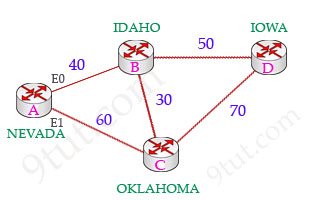EIGRP Tutorial
Feasible Distance (FD) and Advertised Distance (AD)
In the next part, we will define these terms and take an example to make them clear.
Advertised distance (AD): the cost from the neighbor to the destination.
Feasible distance (FD): The sum of the AD plus the cost between the local router and the next-hop router
Successor: The primary route used to reach a destination. The successor route is kept in the routing table. Notice that successor is the best route to that destination.
Feasible successor: The backup route. To be a feasible successor, the route must have an AD less than the FD of the current successor route
Maybe it’s a bit confused with these terms so below is an example to make it clear.

Suppose you are in NEVADA and want to go to IOWA. From NEVADA you need to specify the best path (smallest cost) to IOWA.
In this topology, suppose router A & B are exchanging their routing tables for the first time. Router B says “Hey, the best metric (cost) from me to IOWA is 50 and the metric from you to IOWA is 90” and advertises it to router A. Router A considers the first metric (50) as the Advertised distance. The second metric (90), which is from NEVADA to IOWA (through IDAHO), is called the Feasible distance.
NEVADA also receives the cost path from NEVADA -> OKLAHOMA -> IOWA advertised by router C with the Advertised distance of 70 and Feasible distance of 130.
All of these routes are placed in the topology table of router A:
| Route | Advertised distance | Feasible distance |
| NEVADA -> IDAHO -> IOWA | 50 | 90 |
| NEVADA -> OKLAHOMA -> IOWA | 70 | 130 |
Router A will select the route to IOWA via IDAHO as it has the lowest Feasible distance and put it into the routing table.
The last thing we need to consider is if the route NEVADA -> OKLAHOMA -> IOWA will be considered as a feasible successor. To achieve this, it must satisfy the feasibility condition:
“To qualify as a feasible successor, a router must have an AD less than the FD of the current successor route“
Maybe you will ask “why do we need this feasibility condition?” Well, the answer is because it guarantees a loop-free path to the destination; in other words, it must not loop back to the current successor.
If the route via the successor becomes invalid (because of a topology change) or if a neighbor changes the metric, DUAL checks for feasible successors to the destination route. If one is found, DUAL uses it, avoiding the need to recompute the route as the re-computation can be processor-intensive. If no suitable feasible successor exists, a re-computation must occur to determine the new successor.
EIGRP calls these alternative, immediately usable, loop-free routes feasible successor routes, because they can feasibly be used as a new successor route when the current successor route fails. The next-hop router of such a route is called the feasible successor.
In this case, the route NEVADA -> OKLAHOMA -> IOWA has an AD (70) less than the FD of the successor route (90) so it becomes the feasible successor route.
Of course in some cases the feasibility condition will wrongly drop loop-free paths. For example, if the metric between OKLAHOMA and IOWA is greater than 90 then the route NEVADA -> OKLAHOMA -> IOWA will not be considered as a feasible successor route although it is loop-free. But this condition is necessary because it can guarantee the feasible successor routes are loop-free.
Notice that the feasible successors are placed in the topology table, not in the routing table.
Now router A has 3 complete tables as follows (we only consider route to IOWA network)



Now you have a basic concept of EIGRP, in the next part we will dig into the 3 tables of EIGRP – the neighbor, topology & routing tables as understanding them is a requirement for a CCNA-taker and learn how to calculate the metric of EIGRP.



please share ccnp route dumps and lab. Humble requested.
asgharshahhashmi @ gmail . com
Thanks!!!!
thankyou
Hi you recently moved the questions how can i do the questions i wont pass the exam without doing the questions
Hi All,
EIGRP is not in current 2023 CCNA syllabus right? only OSPF?
I took the exam in April and I do not recall having any EIGRP questions, but things could have changed from then.
Can generative AI be used to improve predictive AI algorithms in networking, and how do these two types of AI differ in their applications and potential impact on network operations?”,
“refusal
Where is the EIGRP request type packet?